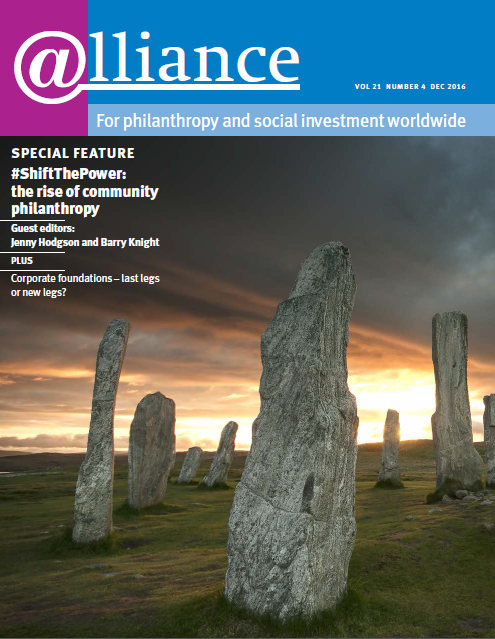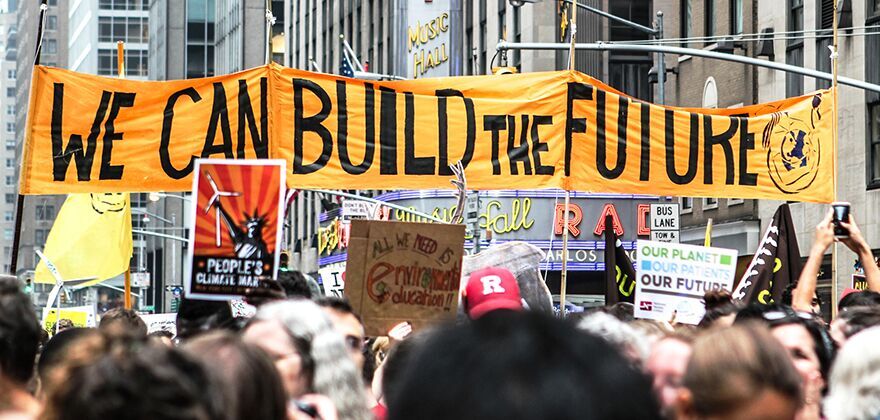The international development landscape is shifting rapidly. In many ways, we’re witnessing the end of the ‘development-industrial complex’ that has dominated the sector for the last two decades. The days of rich northern countries delivering large amounts of official development assistance (ODA) to poor countries in the global south, often via massive northern-based international NGOs, are numbered. A variety of complex and connected factors are driving this shift: radical global socio-economic changes and the emergence of a new, universal, sustainable development agenda, to name but two. The question now is what kind of new development model are we constructing in its place?
Resources trickle down, power does not
For me, a fundamental transfer of power will be the defining feature that distinguishes our new development landscape from the old. In recent years, only about 1 per cent of all official aid, and an even smaller portion of humanitarian assistance, has gone directly to the global south. Research into private foundations suggests that they too channel a large portion of their giving through ‘fundermediaries’ in the global north. The crux of the problem with this approach to development is that resources may trickle down, but power does not. Instead, it remains concentrated in the hands of a relatively small number of big players, predominantly based in the global north.
I often talk, and write, about the science of delivery versus the art of social transformation. But, for me, community philanthropy and local resourcing has the potential to tick both boxes. It has been argued – and demonstrated – again and again that local actors offer more efficient, sustainable development solutions.
If the development agenda is guided by local priorities, if local organizations implement initiatives and programmes and if local in-country bodies are supported to finance – or at the very least co-finance – their own development needs, then sustainability becomes embedded in development. Local resourcing empowers local people; it reduces aid dependency; it breaks the cycle of endless development sector self-serving job creation projects.
Supporting local civil society organizations based within the communities they seek to serve provides the kind of technical efficiency that is so important to the allocation of development resources. But going local is about more than technical efficiency; going local is, above all, political.
The Summit on Community Philanthropy coming up in Johannesburg is being promoted using #ShiftThePower. To me, this encapsulates the real, transformative potential of community philanthropy. It is a shift that will depend upon how prepared donors and others are to disrupt the current development model and to confront the fact that going local is about more than ‘development impact’.
If the development agenda is guided by local priorities, if local organizations implement initiatives and programmes and if local in-country bodies are supported to finance – or at the very least co-finance – their own development needs, then sustainability becomes embedded in development.
In recent years, we have witnessed a worrying global restriction of civil society’s core freedoms. In 2015, my CIVICUS colleagues recorded serious violations of civic space in 109 countries. I would argue that the power imbalances perpetuated by the dominant development modalities of the last two decades have contributed to this trend. Certainly, they have made it more difficult to combat.
‘Accounts-ability’ at the expense of social change
Partly, this is because our funding models have nurtured a cadre of contracted, professionalized civil society organizations. They excel when it comes to ‘accounts-ability’, but are less good at disruptive social change. Advocating for human rights and sustainable social justice is an awkward fit with most donors’ insistence on short-term, measurable projects. For now, it also remains a no-go area for most domestic funders in the global south, leaving the very organizations that may be best positioned to fight back against closing civic space, either severely under-resourced and struggling for survival, or totally reliant on foreign funding.
Local resourcing empowers local people; it reduces aid dependency; it breaks the cycle of endless development sector self-serving job creation projects.
The dominance of ODA and high-level, large-scale funding has also facilitated the ongoing trend for politicized government regulation and the imposition of barriers to what is commonly termed the ‘foreign funding of dissent’. Even as official government donors withdraw, for example, from countries recently designated as middle-income, the dependence they have created (at the expense of home-grown resource bases), leaves a gaping hole that is being quickly filled by repressive governments, intolerant of civic activism and dissent.
Governments then fund only those CSOs that deliver to help achieve their own agendas, some openly using the threat of funding cuts as a way of silencing criticism, and so the independence of the civil society sector becomes dangerously compromised.
It is, of course, a classic catch-22: resourcing community philanthropy would enable civil society to flourish, but the deteriorating conditions faced by civil society around the world make resourcing community philanthropy more difficult.
But going local is about more than technical efficiency; going local is, above all, political.
If we believe, as Paula Johnson writes in WINGS’ 2010 Global Institutional Philanthropy Report, that, ‘for philanthropy to flourish in a society, that society must value a strong and vibrant role for civil society and believe in the role of private actors to support it’, then the campaigns of vilification against civil society – and all the more subtle ways in which civic space is being restricted – are a real problem.
The public in many countries now views CSOs with suspicion, seeing them as self-serving, corrupt or as agents of external forces. Back in 2004, a rapid rise in engagement in charitable activities in some transitioning and developing economies – many home to exploding middle-class populations – raised hopes of a global surge in private donations. But, the relationship between in-country wealth and the proportion of people giving money to charity is not a dependable one: deeper, underlying conditions drive or restrict a culture of giving.
An inherently sustainable philanthropy
But there are glimmers of hope. With growing recognition that the SDG agenda will never be anything more than aspirational unless we’re prepared to radically disrupt the development sector, we’re seeing a new commitment to constructing a more multi-faceted, resilient civil society.
By supporting communities’ efforts to gain control of their own development future, this kind of philanthropy is inherently sustainable.
The last 25 years have seen a 75 per cent increase in the number of community foundations around the world and the diversity and relevance of the community philanthropy field has increased enormously. A well-resourced, established community philanthropy sector would entail our development efforts being grounded in strong relationships of trust, responsive to the evolving needs of communities, as well as to local political and social dynamics.
The public in many countries now views CSOs with suspicion, seeing them as self-serving, corrupt or as agents of external forces.
Because of their independence by comparison to traditional donors and their freedom from the onerous cyclical reporting requirements, delivery criteria, or strict thematic areas of focus of large NGOs, the financial backers of this kind of philanthropy – social investors and grantmakers – can take risks, seed-fund new ideas, test innovation and tolerate a degree of failure.
Perhaps most importantly, by supporting communities’ efforts to gain control of their own development future, this kind of philanthropy is inherently sustainable.
For me, traditional, international donors can play a crucial role in helping to build this young movement. Indeed, if they are at all interested in the lasting impact they might have in developing contexts where they have been active for decades, investing in new forms of development like community philanthropy should be at the top of their list. This will require a nuanced approach and an honest acknowledgment of the politics embedded in their funding decisions. Above all, it will require a willingness to use their power to shift the power.
Danny Sriskandarajah is secretary general of CIVICUS. Email danny.sriskandarajah@civicus.org
Case studies
Luz Aquilante on Feminist philanthropy on the streets of Latin America
Anderson Giovani da Silva on Instilling a sense of co-responsibility in donors
Dana Doan on Developing community philanthropy in Vietnam – part-way there








Comments (0)